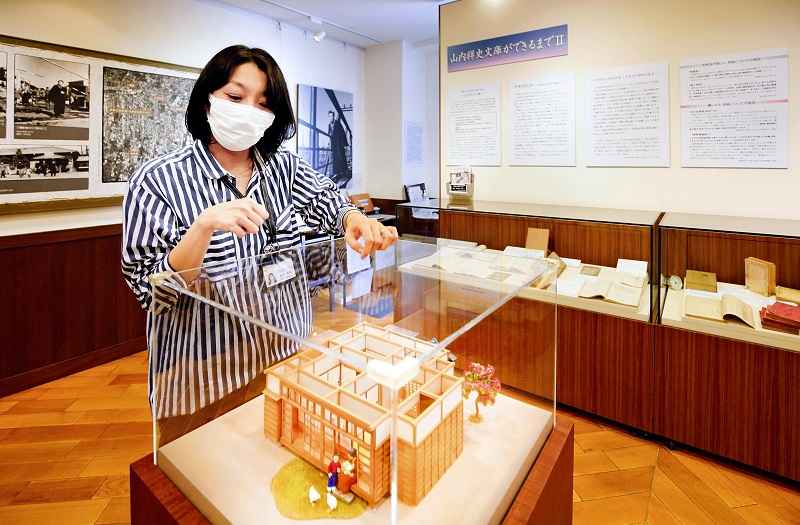
A large photo of the Osamu Dazai welcomes visitors at the entrance of Dazai Osamu Literary Salon.
15:58 JST, October 26, 2021
The Dazai Osamu Literary Salon — opened in Mitaka, Tokyo, in 2008 — was built to showcase the history and legacy of novelist Osamu Dazai (1909-48), who lived in the area for about 7½ years. Mitaka is also where he produced some of his best-known works, such as “Hashire Merosu” (Run, Melos!), “Shayo” (The Setting Sun) and “Ningen Shikkaku” (A Shameful Life), which are still being read today.
Upon entering the building, visitors are greeted by a photo of Dazai in a thoughtful pose. According to a chronological table, Dazai moved from Kofu to Mitaka in 1939 at the age of 30. Mami Yoshinaga, 43, one of the museum’s curators, said that Dazai might have sought to escape the mainstream of literature by not living in Tokyo’s Yamanote area, which was favored by many literary greats.
Mitaka seems to have been convenient for Dazai when traveling to Tokyo’s Kanda and Shinjuku districts, home to many publishing companies, or the Ogikubo area where his mentor Masuji Ibuse lived.

A model of Osamu Dazai’s house is among the exhibits at the Dazai Osamu Literary Salon.
Because of his style of writing in his later years, Dazai has a strong image of a “writer of loneliness.” But memoirs and other pieces of writing left behind by his wife Michiko Tsushima and other writers who were close to Dazai show that the author was full of humor and had a personality that attracted the people around him. A model showcasing the layout of his house, where his disciples are said to have often gathered, is among the museum’s exhibits.

A large hibachi charcoal brazier said to have been used by Dazai
Visitors also learn that the Mitaka area at the time was in the midst of a transition from a rural Musashino area to a town of military industry. As the shadow of World War II darkened, censorship of novels became stricter and those deemed to be anti-war are said to have been banned.
While some authors gave up writing, Dazai continued to write both in Mitaka and in Tsugaru in Aomori Prefecture, where he stayed after evacuating due to the war. His determination is evident as he even published two novels in one month. Yoshinaga said: “As even Ibuse, who was older than Dazai, was conscripted, Dazai, who was not recruited as a soldier because of his bad lungs, considered writing to be his duty.”

A chart shows the relationship between Osamu Dazai, Masuji Ibuse and other great writers.
The Dazai Osamu Literary Salon is located on the first floor of an apartment building. Although it is not very spacious, the atmosphere is cozy, making it easy for visitors to ask a curator detailed questions. Visitors to the facility are sure to get a more concrete image of Dazai as they are given a glimpse into lesser-known aspects of the writer.

Dazai Osamu Literary Salon
1F, Grand Jardin Mitaka, 3-16-14, Shimorenjaku, Mitaka, Tokyo
Related Tags
"Features" POPULAR ARTICLE
-

Sanrio to Open Museum in Yamanashi Pref. Dedicated to Founder, Exhibits Include Hello Kitty, Other Characters
-

Autumn Foliage Surrounds Visitors to Tokyo’s Showa Kinen Park
-

My Daughter No Longer Speaks to Me, But I Want to See Her and My Grandchild
-

Kumamoto: Public Bath Refurbished as Library Where You Can Chat, Take Photos
-

Frozen Vegetables: Demand Rises for Convenient, Tasty Domestic Produce
JN ACCESS RANKING
-

Keidanren Chairman Yoshinobu Tsutsui Visits Kashiwazaki-Kariwa Nuclear Power Plant; Inspects New Emergency Safety System
-

Imports of Rare Earths from China Facing Delays, May Be Caused by Deterioration of Japan-China Relations
-

University of Tokyo Professor Discusses Japanese Economic Security in Interview Ahead of Forum
-

Japan Pulls out of Vietnam Nuclear Project, Complicating Hanoi’s Power Plans
-

Govt Aims to Expand NISA Program Lineup, Abolish Age Restriction






















